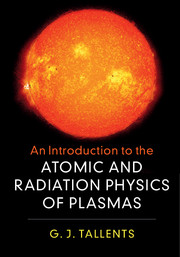Book contents
- Frontmatter
- Contents
- Preface
- 1 Plasma and Atomic Physics
- 2 The Propagation of Light
- 3 Scattering
- 4 Radiation Emission in Plasmas
- 5 Radiation Emission Involving Free Electrons
- 6 Opacity
- 7 Discrete Bound Quantum States: Hydrogen and Hydrogen-Like Ions
- 8 Discrete Bound States: Many-Electron Atoms and Ions
- 9 Discrete Bound States: Molecules
- 10 Radiative Transitions between Discrete Quantum States
- 11 Collisions
- 12 Collisional-Radiative Models
- 13 High-Density Plasmas
- Appendix Vectors, Maxwell's Equations, the Harmonic Oscillator and a Sum Rule
- References
- Index
2 - The Propagation of Light
Published online by Cambridge University Press: 21 February 2018
- Frontmatter
- Contents
- Preface
- 1 Plasma and Atomic Physics
- 2 The Propagation of Light
- 3 Scattering
- 4 Radiation Emission in Plasmas
- 5 Radiation Emission Involving Free Electrons
- 6 Opacity
- 7 Discrete Bound Quantum States: Hydrogen and Hydrogen-Like Ions
- 8 Discrete Bound States: Many-Electron Atoms and Ions
- 9 Discrete Bound States: Molecules
- 10 Radiative Transitions between Discrete Quantum States
- 11 Collisions
- 12 Collisional-Radiative Models
- 13 High-Density Plasmas
- Appendix Vectors, Maxwell's Equations, the Harmonic Oscillator and a Sum Rule
- References
- Index
Summary
To achieve a plasma with free electrons requires elevated temperatures and hence light emission, propagation and absorption can be important. The propagation of light, unlike many other familiar waves, does not need a medium in which to oscillate. Light propagates in plasma and the free electrons are driven to oscillate, but the electrons generally impede the wave oscillation rather than aid the process. It becomes impossible for light to travel through an unmagnetised plasma if the frequency of the radiation is less than the plasma's natural oscillation frequency: the plasma frequency is discussed in Section 1.1. At low frequencies, the electron oscillations relative to the ions dampen the electromagnetic oscillation of light. Light of all frequencies passes with no absorption or alteration in phase in vacuum, though the intensity from any finite-sized source ultimately falls proportionally to the inverse of the square of distance from the source.
In this chapter, we show how Maxwell's equations describing the relationships between electric and magnetic fields (and electric current and electric charge) are consistent with oscillating electric and magnetic fields propagating in vacuum at the velocity of light c. The oscillating fields are solutions of Maxwell's equations. We treat the electric currents generated in a plasma by light to show how the currents affect electromagnetic waves. The acceleration of any charge is shown to produce transverse electric field oscillations, thus providing a mechanism for the production of electromagnetic waves.
The electromagnetic spectrum of interest in plasma physics ranges from radio waves to X-rays and gamma rays (see Figure 2.1). The propagation of the different components of the electromagnetic spectrum involves identical physics with variations only occurring when the radiation interacts with matter. The highestfrequency, highest-energy gamma rays at photon energies above, say, 100 keV are not created typically by thermal processes, but can be important when fast ‘superthermal’ particles are created in plasmas. Radio-wave propagation can be important in low-density plasmas, such as the ionosphere.
Electromagnetic Waves in Plasmas
The propagation of radiation through a medium can be examined using Maxwell's equations.
- Type
- Chapter
- Information
- Publisher: Cambridge University PressPrint publication year: 2018



